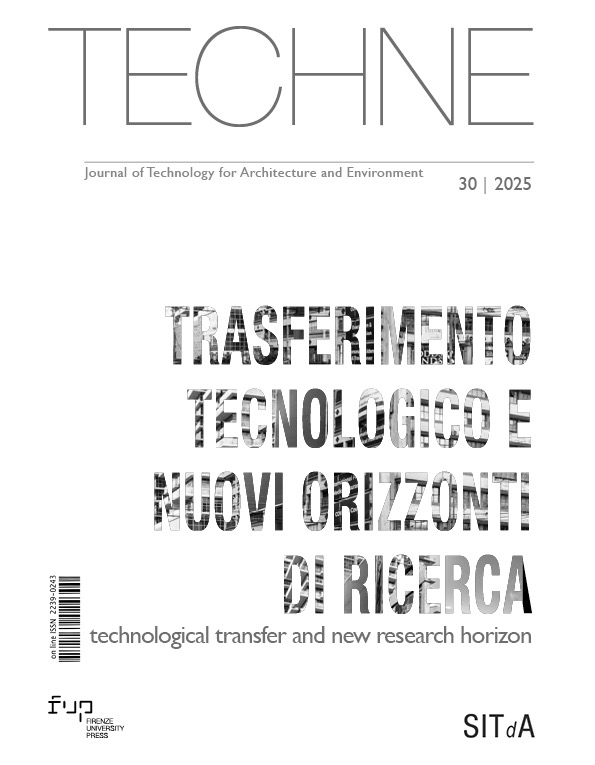Published 2025-11-07
Keywords
- University third mission,
- Open innovation,
- Data-driven methodologies,
- Urban resilience
How to Cite
Copyright (c) 2025 Rossella Roversi, Andrea Boeri, Francesca Sabatini

This work is licensed under a Creative Commons Attribution 4.0 International License.
Abstract
The university today is called upon to play a key role in the innovation and regeneration of territorial systems through the Third Mission, which combines research and teaching with technology transfer and knowledge co-creation initiatives. However, there remains a gap between theory and practice, which tends to reduce Third Mission to mere dissemination. This paper contributes to bridging the gap by presenting an integrated, co-designed and data-driven approach to open innovation that integrates stakeholders from the earliest stages of the process. Strategies and actions are presented in the framework of action-research in European projects where digital tools and quintuple helix collaboration generate impacts and enable long-term technology transfer.
Downloads
References
- Baldwin, C. and Von Hippel, E. (2011), “Modeling a paradigm shift: From producer innovation to user and open collaborative innovation”, Organization Science, Vol. 22, No. 6, pp. 1399-1417. Available at: https://doi.org/10.1287/orsc.1100.0618 (Accessed on 25/02/2025). DOI: https://doi.org/10.1287/orsc.1100.0618
- Carayannis, E.G. and Campbell, D.F. (2009), “‘Mode 3’ and ‘Quadruple Helix’: toward a 21st century fractal innovation ecosystem”, International Journal of Technology Management, Vol. 46, Nos. 3-4, pp. 201-234. Available at: https://doi.org/10.1504/IJTM.2009.023374 (Accessed on 04/02/2025). DOI: https://doi.org/10.1504/IJTM.2009.023374
- Chesbrough, H. (2003), Open Innovation: The New Imperative for Creating and Profiting from Technology, Harvard Business School Press, Boston, MA.
- Compagnucci, L. and Spigarelli, F. (2020), “The Third Mission of the university: A systematic literature review on potentials and constraints”, Technological Forecasting and Social Change, Vol. 161, p. 120284. Available at: https://doi.org/10.1016/j.techfore.2020.120284 (Accessed on 28/03/2025). DOI: https://doi.org/10.1016/j.techfore.2020.120284
- Eden, C. and Ackermann, F. (2018), “Theory into practice, practice to theory: Action research in method development”, European Journal of Operational Research, Vol. 271, No. 3, pp. 1145-1155. Available at: https://doi.org/10.1016/j.ejor.2018.05.061 (Accessed on 28/03/2025). DOI: https://doi.org/10.1016/j.ejor.2018.05.061
- Etzkowitz, H. and Leydesdorff, L. (2000), “The dynamics of innovation: from National Systems and ‘Mode 2’ to a Triple Helix of university-industry-government relations”, Research Policy, Vol. 29, No. 2, pp. 109-123. Available at: https://doi.org/10.1016/S0048-7333(99)00055-4 (Accessed on 14/02/2025). DOI: https://doi.org/10.1016/S0048-7333(99)00055-4
- European Union (2020), Knowledge Transfer Metrics. Towards a European-wide Set of Harmonised Indicators, European Commission. Available at: https://publications.jrc.ec.europa.eu/repository/handle/JRC120716 (Accessed on 04/02/2025).
- European University Association (2023), EUA Innovation Agenda 2026. Available at: https://www.eua.eu/downloads/publications/eua%20innovation%20agenda%202026.pdf (Accessed on 04/02/2025).
- Gibbons, M., Limoges, C., Nowotny, H., Schwartzman, S., Scott, P. and Trow, M. (1994), The New Production of Knowledge: The Dynamics of Science and Research in Contemporary Societies, SAGE, London.
- Lindvall, D. (2021), Democracy and the Challenge of Climate Change, IDEA Publications. Available at: https://www.idea.int/publications/catalogue/democracy-and-challenge-climate-change (Accessed on 25/02/2025). DOI: https://doi.org/10.31752/idea.2021.88
- Losasso, M. (2014), “Ricerca, progetto architettonico e trasferimento delle conoscenze”, TECHNE – Journal of Technology for Architecture and Environment, Vol. 8, pp. 8-12. Available at: https://doi.org/10.13128/Techne-15050 (Accessed on 25/02/2025).
- Magliacani, M. (2023), “How the sustainable development goals challenge public management. Action research on the cultural heritage of an Italian smart city”, Journal of Management and Governance, Vol. 27, No. 3, pp. 987-1015. Available at: https://doi.org/10.1007/s10997-022-09659-3 (Accessed on 25/02/2025). DOI: https://doi.org/10.1007/s10997-022-09652-7
- Medina, M.G. and Huete García, M.Á. (2020), “Real innovation in urban planning? Assessing the institutional capacity in the frame of the integrated sustainable urban development programmes”, European Planning Studies, Vol. 28, No. 6, pp. 1139-1160. Available at: https://doi.org/10.1080/09654313.2019.1675601 (Accessed on 02/03/2025). DOI: https://doi.org/10.1080/09654313.2019.1675601
- Pelagallo, F., Pellegrini, M.M., Giannitelli, R. and Sartini, P. (2021), “University and social innovation: the case of an urban regeneration in the Municipality of Rome”, International Journal of Public Sector Performance Management, Vol. 7, No. 2, pp. 264-286. Available at: http://dx.doi.org/10.1504/IJPSPM.2021.10036678 (Accessed on 02/03/2025). DOI: https://doi.org/10.1504/IJPSPM.2021.114044
- Perulli, A., Rostan, M. and Semenza, R. (Eds.) (2019), La terza missione degli accademici italiani, Il Mulino, Bologna.
- Porta, L. (2021), “Terza Missione: come si misura il trasferimento di conoscenza”, Riflettere | Proporre | Agire, 17 April. Available at: https://educationaround.org/blog/2021/04/17/terza-missione-come-si-misura-il-trasferimento-di-conoscenza/ (Accessed on 25/04/2025).
- Pundt, H. and Heilmann, A. (2020), “Building collaborative partnerships: an example of a 3rd mission activity in the field of local climate change adaptation”, in Leal Filho, W., Salvia, A.L., Pretorius, R.W. and Brandli, L.L. (Eds.), Universities as Living Labs for Sustainable Development: Supporting the Implementation of the Sustainable Development Goals, Springer, Cham, pp. 621-636. Available at: https://doi.org/10.1007/978-3-030-15604-6_38 (Accessed on 04/03/2025). DOI: https://doi.org/10.1007/978-3-030-15604-6_38
- Ranga, M. and Etzkowitz, H. (2013), “Triple Helix Systems: An Analytical Framework for Innovation Policy and Strategy in the Knowledge Society”, Triple Helix International Conference. Available at: http://dx.doi.org/10.5367/ihe.2013.0165 (Accessed on 04/03/2025). DOI: https://doi.org/10.5367/ihe.2013.0165
- Thorsten, D.B. (2011), “The Idea of a Green New Deal in a Quintuple Helix Model of Knowledge, Know-How and Innovation”, International Journal of Social Ecology and Sustainable Development, Vol. 2, No. 1, pp. 1-14. Available at: https://ideas.repec.org/a/igg/jsesd0/v2y2011i1p1-14.html (Accessed on 25/02/2025). DOI: https://doi.org/10.4018/jsesd.2011010101
- Turriziani, L. (2024), Il processo di trasferimento tecnologico universitario, Wolters Kluwer, Alphen aan den Rijn.






